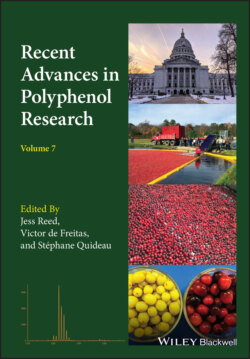Читать книгу Recent Advances in Polyphenol Research - Группа авторов - Страница 22
1.4.3 6,8 Rearrangements
ОглавлениеIn Scheme 1.13, the 6,8 rearrangement is shown. Two necessary requirements are needed to observe this reaction in flavylium‐derived systems: (i) a hydroxyl group in position C5 and (ii) the lack of symmetry through the binary axis identified in Scheme 1.13 by the traced line. For example, with the natural symmetrical 3‐deoxyanthocyanidins such as luteolinidin and apigeninidin, the 6,8 rearrangement is not observed. The 6,8 rearrangement in the flavylium cation was first reported (Jurd 1963) for 4’,5,7,8‐tetrahydroxyflavylium and for 6/8‐C‐glycosyl‐3‐deoxyanthocyanidins (Bjorøy et al. 2009). More recently, a complete study extended to the other species of the multistate present in moderately acidic medium was reported (Scheme 1.13), R=Br (Cruz et al. 2016, 2017).
In very acidic medium, equilibrium is established between c. 50% of each flavylium cation. The two flavylium cation isomers were separated by HPLC and lyophilized. The usual pH jumps followed by stopped flow permitted us to obtain the absorption spectra of the two neutral quinoidal base isomers and study the respective kinetic processes. At pH=3.7 (Figure 1.7), the equilibrium absorption spectrum can be fitted with the contributions of 0.45A6 + 0.45A8 + 0.1Ct.
In the case of the 6,8 rearrangements for R=CH3 or phenyl (Basílio et al. 2017) the 8 derivative is the only one observed and equilibrium in moderately acidic medium is established between A8 and Ct (c. 20%). The pH‐dependent equilibrium between flavylium cation and a mixture of quinoidal base (major species) and trans‐chalcone was previously reported for 5‐deoxyanthocyanidins (Sousa et al. 2014; Brouillard et al. 1982). At moderately acidic pH values there is some spectral evidence that the two quinoidal base isomers are in equilibrium, but the spectral variations are relatively small. In order to unveil the two isomers other strategies should be used; see below.
Scheme 1.13 General scheme of the 6,8 rearrangement. R=Br or R=CH3 or R=Phenyl.
Source: Adapted from Cruz et al. 2016. © 2016 John Wiley & Sons.
Figure 1.7 The absorption spectra of equilibrated solutions of the compound 8‐bromo,4′,5,7 trihydroxyflavylium R=Br (3.3x10‐5 M) at pH=3.7 can be fitted with a contribution of 0.45A6+0.45A8+0.1Ct.
Source: Adapted from Cruz et al. 2016. © 2016 John Wiley & Sons.
